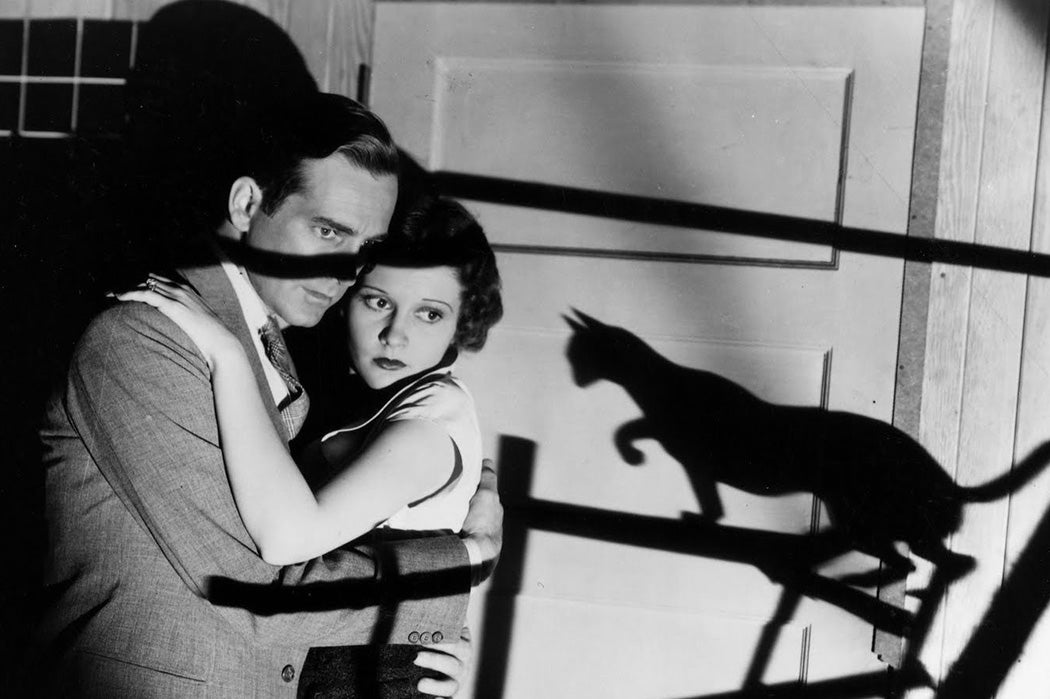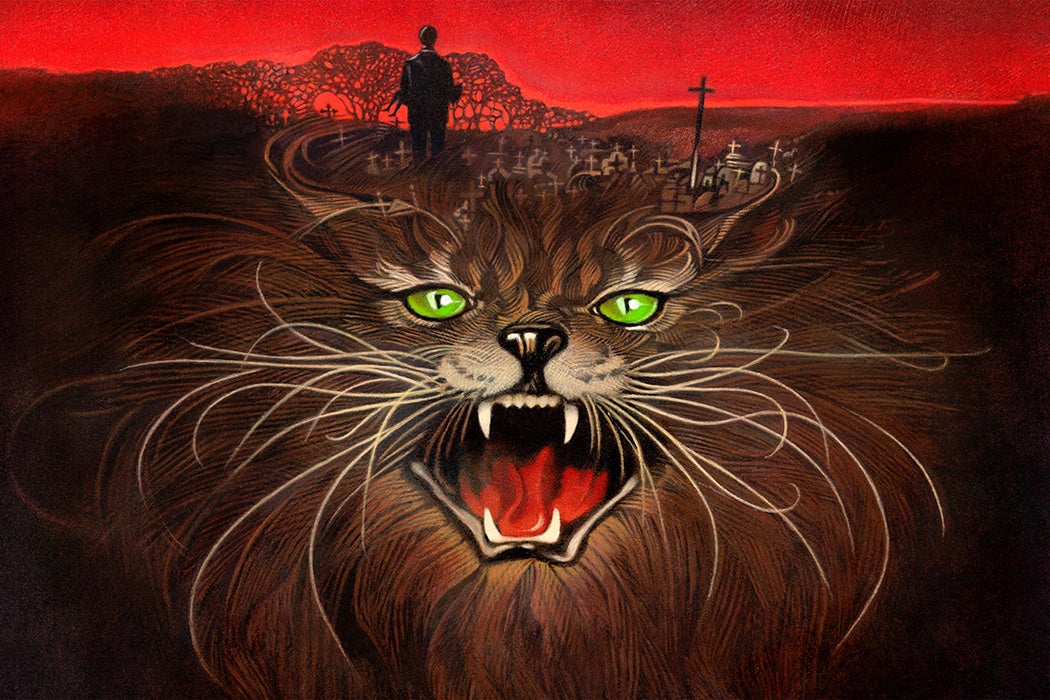“There is no shortage of monsters to haunt our dreams” begins the trailer for the 1977 horror anthology film The Uncanny. However, the voiceover warns, “the most fiendish, the most fascinating, the most terrifying creature of all may be waiting for you around the next corner… or living right in your own home.” This monster is none other than the domestic housecat.
Cats serve as the primary source of terror in more than thirty films, spanning the heyday of horror, from 1934’s pre-Code The Black Cat to the 2019 adaptation of Stephen King’s Pet Sematary. This count does not include all of the horror films that throw cats at the protagonist to build tension or employ them as menacing companions to the primary monster. Cats also figure broadly in horror fiction, ranging from murderous felines on horseback in 1561’s Beware the Cat to shapeshifting women in the 1984 follow-up to the children’s horror classic Scary Stories to Tell in the Dark.
Weekly Newsletter
There is such a surfeit of cat horror stories that there exist not one, but two anthologies on the trope—Twists of the Tale: Cat Horror Stories and Beware of the Cat: Stories of Feline Fantasy and Horror —and a book-length study of regional revenant cats in Ghost Cats of the South. How do cats straddle the line between “I Can Haz Cheeseburger” and “I Can Haz Murder?” One may trace the feline’s role in horror to two distinct devices: the tension-release and the avenging moral mirror.
Spring-Loaded Cats
There’s a killer on the loose and the film’s final girl is more than likely alone, possibly in the dark, when she is startled by a noise off screen. To the dismay of the audience—who suspect the killer will strike at any moment—the final girl decides to investigate the noise. Tension builds as she opens something (a window, a cabinet, a door, a refrigerator) and out jumps a cat!
Variably known as the Lewton Bus, Cat Scare, or Spring-Loaded Cat, this subgenre of the jump scare is perhaps the most recognizable instance of cats in horror, so much so that the Cat Scare has become a point of humor in horror parody. In fact, this trope is so common that there’s a three minute compilation of Cat Scares in horror media called “It’s Just a Cat.”

Named after a scene in producer Val Lewton’s 1942 feline horror classic, Cat People, the first Cat Scare did not involve a cat at all. Instead, tension builds as a woman walks alone, believing she is being followed by her romantic rival, who may or may not be under an ancient curse that turns her into a cat. The tension reaches its crescendo with a loud cat-like hiss—an intentional misdirection for the audience, who believe the woman is about to be attacked by the titular cat person. Instead, the true source of the sound, a bus, enters the frame, simultaneously removing the woman from the potential danger while also showing that there was no real danger from the start. Actual cats were added to the Cat Scare several decades later, with films like Amityville Horror and Alien, and they have continued to pop out on unsuspecting victims ever since.
Horror is a genre of fear and monsters. The primary fear, according to the film scholar Dennis L. White, is that of the unknown, “of being unable to deal with our environment.” The monster in horror (as opposed to more benign monsters from fantasy and science fiction) is a figure beyond our comprehension or control. Given the scope of monsters, from cannibal serial killers like Hannibal Lecter to rampaging sharks like Jaws, attempts to explain what constitutes a monster have been fraught.
The philosopher of art Noël Carroll has, not without controversy, suggested that monsters defy science and elicit fear and disgust in audiences. Hannibal Lecter and Jaws are horror monsters because the former, while human, exhibits a psyche that defies science, while the latter has cognition and agency beyond a typical shark, making both “fanciful, fictional extrapolations” of reality that elicit fear.

According to Carroll’s criteria, felines responsible for Cat Scares are not horror monsters because they are doing exactly what cats do—as anyone who has lived with a cat knows, they act like this regardless of whether there is a murderer present. In this sense, the Cat Scare and the humorous cat meme are separated by no more than the presence of a masked killer. Otherwise, in both horror and humor, cats knock things over, pop out of seemingly impossible hiding places, dart around for no apparent reason, and have a penchant for tripping humans.
On the practical side, Cat Scares fulfil an essential function in horror: withholding the real monster’s appearance. Cat Scares also play a symbolic role in horror, showing the human protagonists that sometimes the greatest horror is what hides behind the mundane, just waiting to emerge into the world.
Cats as Avenging Moral Mirrors
The animalization of the human is a common element of horror. In fact, animalization is such a staple of the genre that Stephen King, in Danse Macabre, devotes one of three tropes (what he calls a horror Tarot deck) to the animalized monster: the Werewolf. While the Werewolf is the most common form of animalization, there are notable examples of the human-cat monster, particularly 1942’s Cat People, Mick Garris’ 1992 Sleepwalkers, and examples from folklore. Cases of horror werecats deal with sexuality, particularly cultural anxieties about women’s sexuality. Interestingly, in both cases, domestic cats are at odds with their werecat counterparts. It is here, in the domestic housecat, that the second motif of feline horror emerges.
White (the film scholar) suggests that horror is not merely a form of entertainment, but a way of being in the world. According to scholar Paul Santilli, part of the appeal of art-horror may be that it “taps into this existential ground and exhibits it in a recognizably chilling story or scary movie.” Save for the above examples of werecats, avenging felines in horror act and behave the same way domestic housecats behave in reality. The avenging cat does not grow to gigantic proportions, it does not gain superhuman strength, and only rarely is it made over to look more horrifying. The only alteration is that the cat seems to demonstrate higher cognition, planning, and agency, all of which contribute to the feline’s desire for revenge—and ability to exact it.

In his analysis of non-horrifying animal stories, Michael J. Rosen notes that such tales draw attention to “human responsibility, the limitations of protection, the boundaries of compassion.” Stories about cats, especially those in the horror genre, tell more about humans than the animal at hand. Felines in horror often become monstrous agents of revenge after someone has wronged them or their beloved human companion. Cats in horror hold perpetrators responsible for otherwise closed-door domestic crimes that may have gone unpunished. The magnitude of the cat’s evil is a mere peccadillo compared with the human-perpetrated crime of passion, jealousy, or greed that triggers the feline’s revenge.
Unlike other horror monsters, the avenging cat often seeks justice using methods grounded in reality. For example, there are several films where cats devour the flesh of their victims. While these victims are often eaten alive to heighten the horror effect, in reality, cats (along with most other non-human animals) will indeed eat the flesh of deceased humans. (This fact is so pervasive that even children are aware of it.) Additionally, through their revenge, cats upend the human-animal hierarchy by stripping the offending human of their sense of control.
Perhaps what makes felines in horror most terrifying isn’t the cat’s potential to eviscerate our jugular, dismantle the human-animal hierarchy, or devour our soft tissue, but rather the cat’s power to bear witness, to hold humans accountable for their transgressions. Cats add a moral dimension to the genre. By their very presence, they remind us of the potential horror we may face should we meet our true selves—the person we become behind closed doors. The cat in horror also challenges our often-overinflated view of human morality. As a moral agent, the feline responsible for the Cat Scare takes on a new meaning: the horror isn’t just the inhuman, incomprehensible monster who seems so distinct from us, but is our own psyche, lying hidden, just waiting to show itself out in the open.







